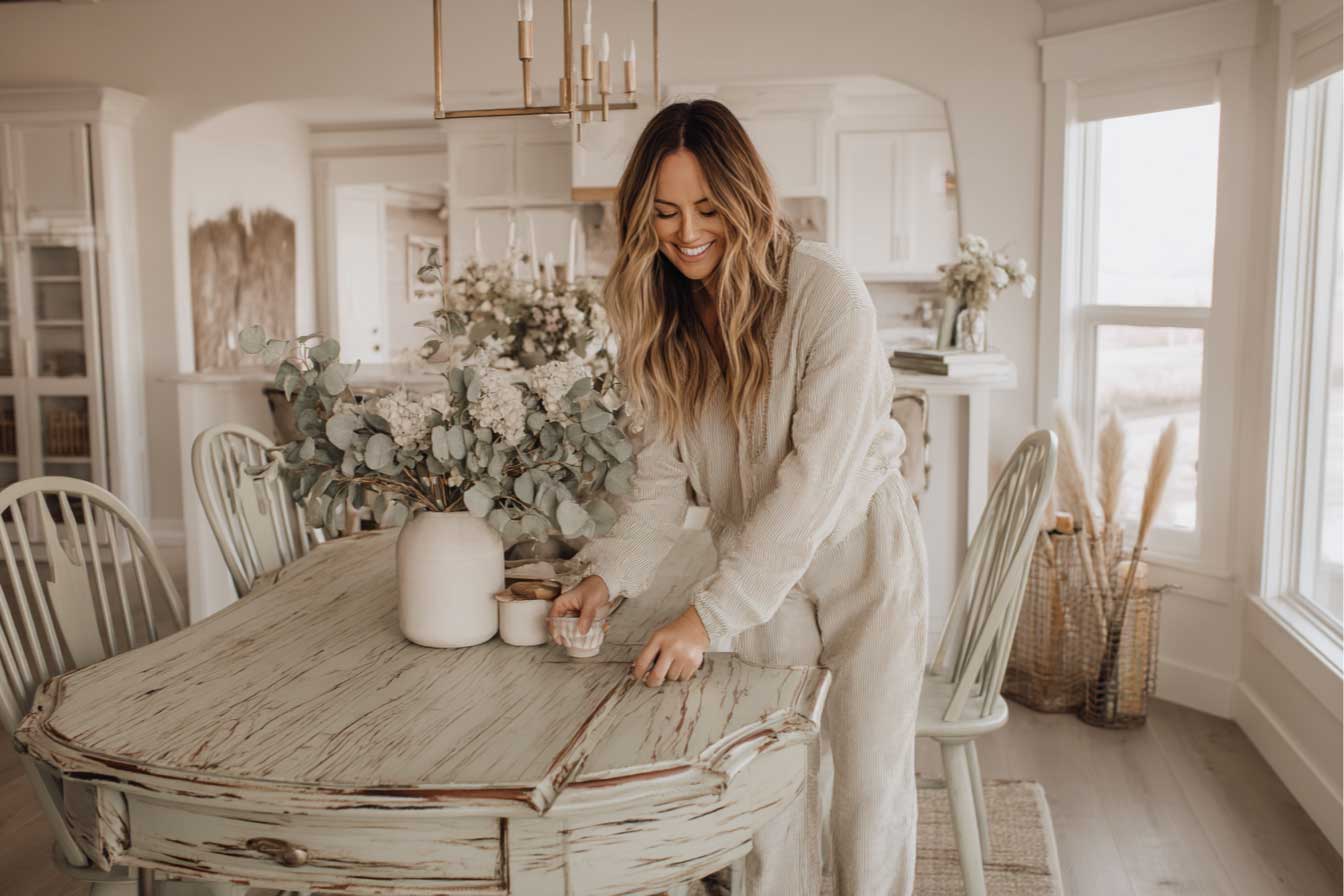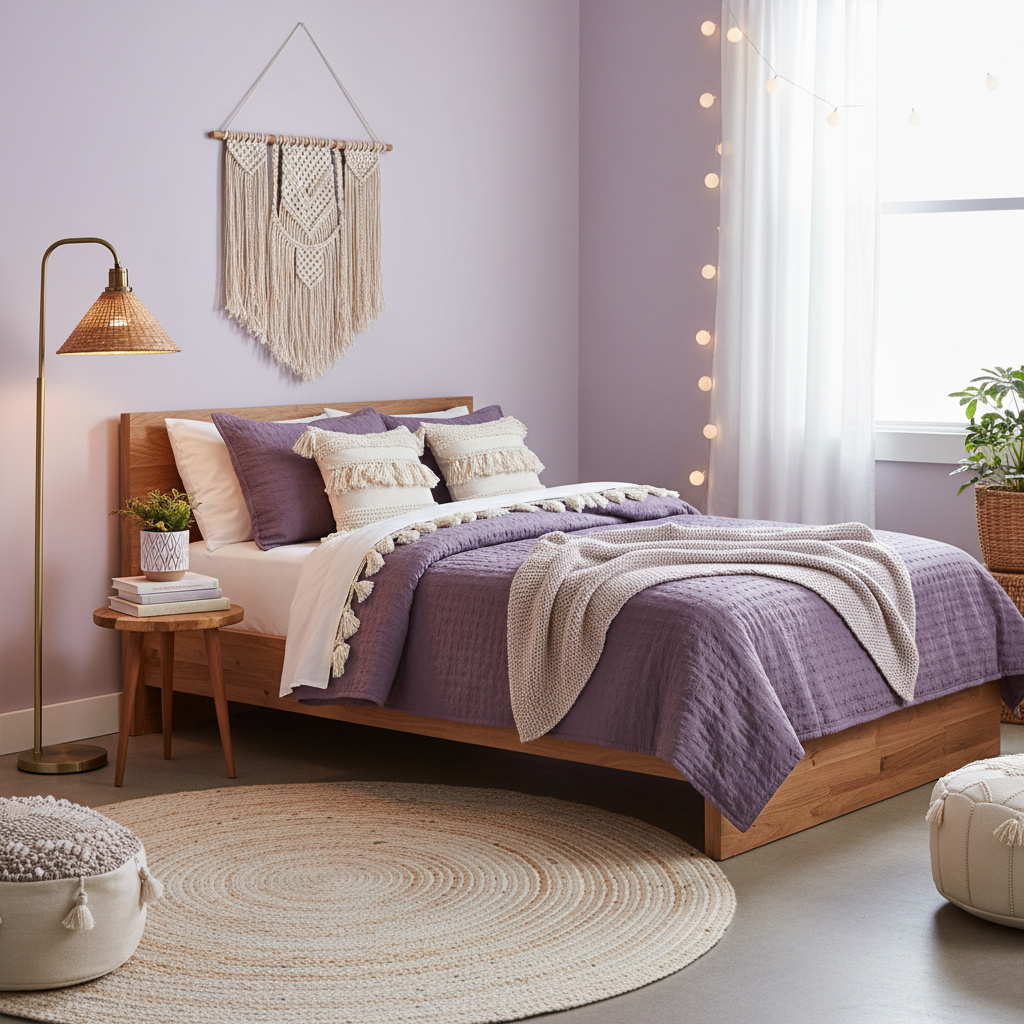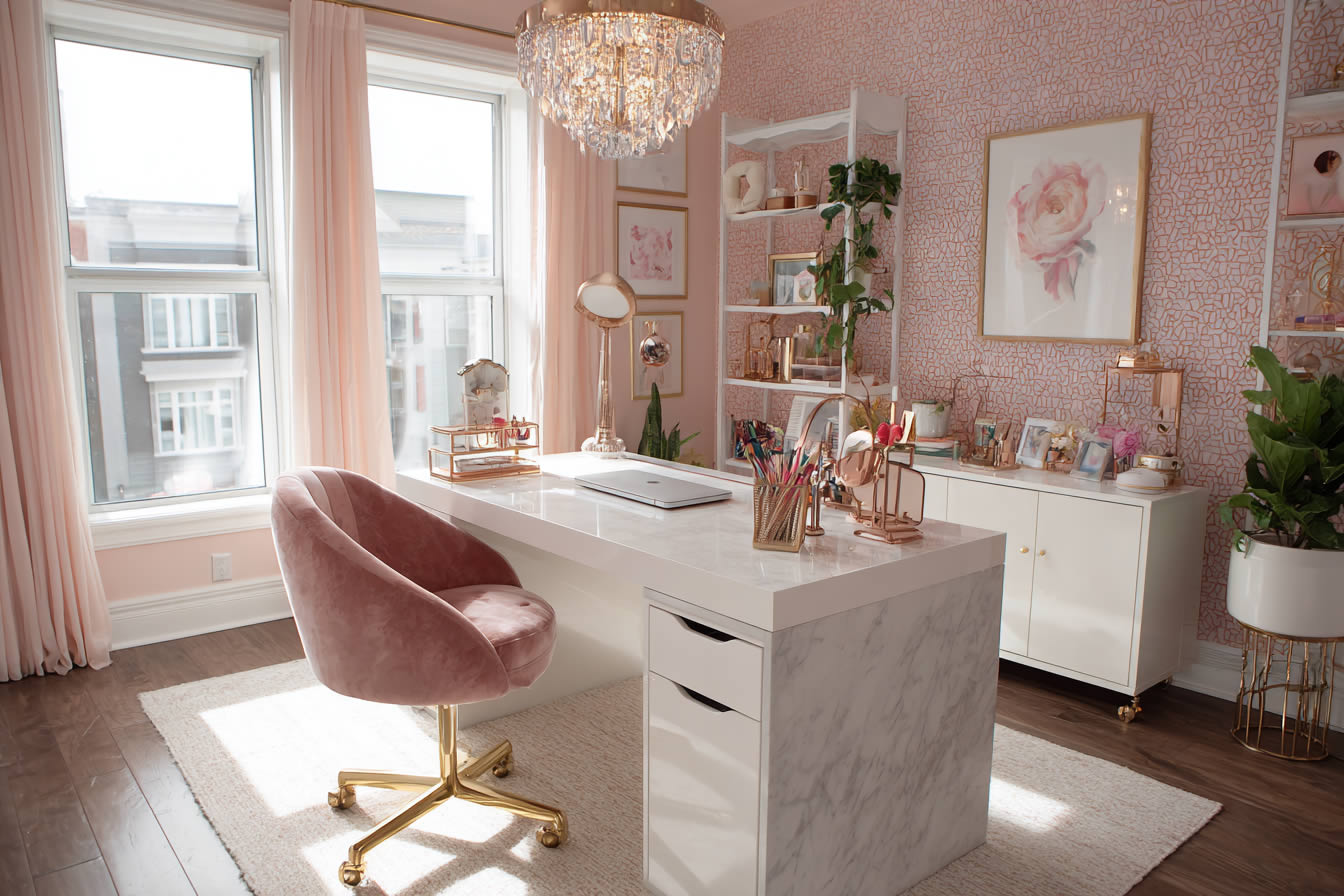Transforming a tired old table into your home’s newest showstopper is one of my favorite design challenges.
It’s amazing what a little creativity can do.
These budget-friendly old table makeover ideas can turn forgotten furniture into stunning focal points that elevate any room in an instant.
1) Chalk Paint Distressed Finish

Chalk paint is magic for creating that coveted farmhouse vibe. You can get the look without the hefty price tag of an authentic vintage piece.
The beautiful matte finish hides imperfections. It also adds instant character to any surface, new or old.
I find the forgiving nature of chalk paint is perfect for first-time furniture flippers. The best part is that no primer is needed, so you can start painting almost immediately.
Sanding the high-traffic areas creates natural-looking wear patterns. This mimics the look of a piece that’s been loved for years.
Distressing reveals glimpses of the wood underneath, making a new table look like a cherished heirloom.
The entire process can be done in a single weekend. The charming results will last for decades with proper care.
It’s a rewarding weekend project.
A final coat of wax will protect the finish and give it a soft, velvety feel.
2) Geometric Stencil Pattern

A bold geometric pattern can transform a plain tabletop into an eye-catching statement piece. Hexagons create modern sophistication, while chevrons add playful energy.
Stenciling is an incredibly affordable technique. It delivers a custom look that appears professionally designed.
I enjoy how geometric designs work with any decor style, from minimalist to maximalist. Contrasting colors make the pattern pop, while tonal variations create a more subtle texture.
For a romantic look, even paper doilies can be used to create stunning, lace-like patterns.
Perfect registration matters less than you think because slight imperfections add handmade charm.
This is a chance to add a huge dose of personality to a simple piece of furniture.
It’s a true showstopper.
A clear topcoat is essential to protect your hard work from daily wear and tear.
3) Epoxy Resin River Design

An epoxy resin river is a mesmerizing focal point for any room. The blue epoxy mimics flowing water through the natural wood grain.
The glossy surface reflects light beautifully, just like actual water. It also provides a durable, waterproof protection against spills.
I notice how different lighting changes the resin’s appearance throughout the day. It’s a dynamic piece that always looks interesting.
Mixing metallic powders into clear resin is a great trick. This creates shimmering effects that catch every eye.
This technique transforms damaged tabletops into conversation-starting art pieces.
While professional results require patience during the 48-hour curing process, it’s worth the wait.
The result is living art.
Mistakes can even become happy accidents when you embrace the organic, unpredictable flow of liquid resin.
4) Decoupage Map Technique

Covering a tabletop with vintage maps creates a wanderlust-inspiring surface. It’s a natural conversation starter about travel dreams and memories.
Mod Podge is the perfect adhesive for this project. It seals the paper securely while maintaining the authentic aged appearance of antique cartography.
I was amazed at how overlapping the map sections can create a dimensional depth. You get a layered look without any additional materials.
Tourist maps from your favorite destinations add a wonderful personal meaning to the piece. For a different theme, sheet music can create equally stunning results for music lovers.
Each section tells a different story, making every meal feel like a global adventure.
Atlas pages work beautifully for smaller accent tables. A full world map is perfect for a larger dining surface.
It’s a story on a tabletop.
A few coats of a durable sealant will protect your map from spills and daily use.
5) Weathered Barn Wood Look
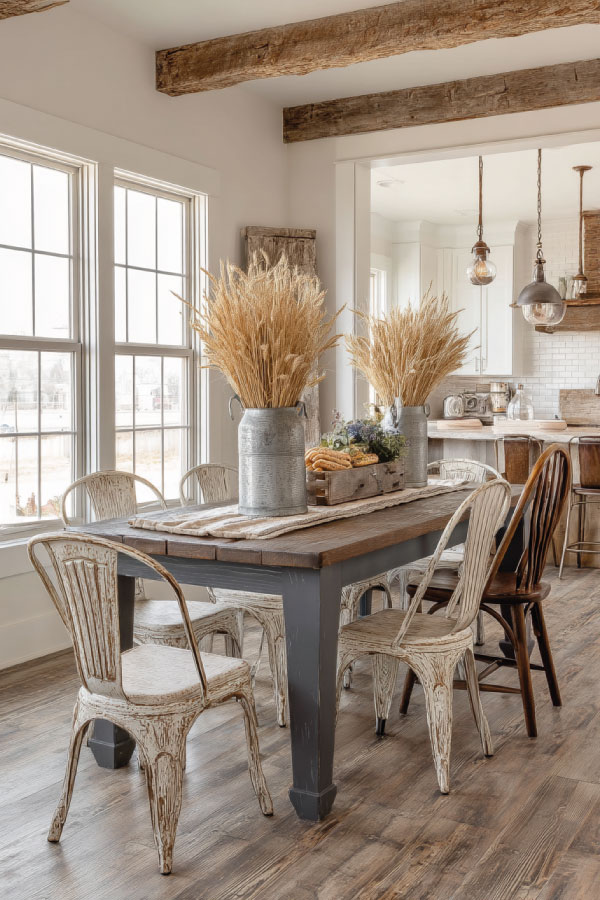
A gray weathering stain can mimic decades of natural aging in just a few hours. It’s a fantastic way to get an authentic rustic look.
A great pro tip is to use a wire brush before staining. This raises the grain for a texture that feels genuinely weathered.
I find this technique is wonderfully forgiving. Any irregularities in the stain just enhance the final result rather than detract from it.
Layering multiple stain colors creates a complex patina. The surface will appear to change under different lighting conditions.
This finish makes any table look like it was rescued from a century-old farmhouse.
This rustic appeal works perfectly even in modern spaces. It acts as a grounding, natural element.
It has instant history.
Always seal the table with a matte polyurethane. This preserves the weathered appearance while ensuring it holds up to daily use.
6) Mosaic Tile Tabletop
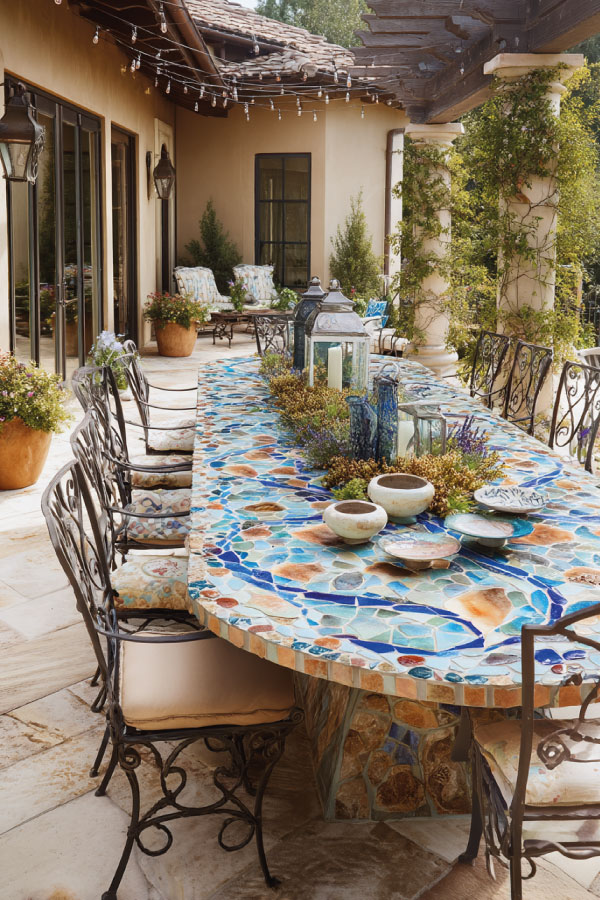
Broken ceramic pieces can create stunning mosaic patterns. It’s a wonderful way to turn an accident into an artistic opportunity.
Thrift store dishes are a goldmine for this project. They provide endless color combinations while keeping your costs remarkably low.
I enjoy how each mosaic tells a unique story. It’s built from the accumulated fragments of different, once-loved pieces.
The irregular shapes add an organic movement that machine-made tiles simply can’t replicate. While some planning helps, letting creativity flow often yields the most beautiful results.
Grouting transforms random pieces into a cohesive design that looks professionally installed.
This is a project that’s as much about the process as the final product. It’s incredibly satisfying to create.
It’s a one-of-a-kind creation.
When sealed properly, a mosaic surface can withstand daily use while maintaining its colorful brilliance for years.
7) Burnt Wood Shou Sugi Ban

Shou Sugi Ban is an ancient Japanese technique for preserving wood. It creates a dramatic, blackened surface with the natural wood grain showing through.
The controlled burning develops unique, crocodile-like patterns. This makes each piece absolutely one-of-a-kind.
The charred surface is naturally resistant to insects and moisture. I find it’s also surprisingly low-maintenance.
A wire brush is used after burning to remove loose charcoal. This step is what emphasizes the dramatic grain patterns.
Fire reveals hidden grain patterns invisible in unstained wood, creating unexpected beauty.
Proper safety equipment is non-negotiable for this technique. The stunning results justify the extra precautions you need to take.
The texture is incredible.
The contrast between the black char and the natural wood is incredibly striking in modern interiors.
8) Concrete Overlay Finish

A concrete overlay creates an industrial-chic surface. It pairs beautifully with both rustic and contemporary decor styles.
The thin overlay adds minimal weight to the table. You get the concrete look with incredible durability for heavy daily use.
I was surprised how well concrete accepts stains and dyes. This allows for completely customized color palettes beyond the standard gray.
You can even mix in aggregates like recycled glass chips. This creates a custom texture that reflects your personal style.
Polishing reveals beautiful aggregate patterns and creates a smooth surface for dining.
For those not ready to commit to a full overlay, concrete-look paint can deliver a similar aesthetic with much less effort.
It’s a cool, modern finish.
Sealing the finished surface is essential to prevent stains while maintaining that authentic industrial appearance.
9) Rope-Wrapped Pedestal Base

Wrapping a pedestal base with natural fiber rope adds instant coastal texture. The whole room is transported to a seaside retreat.
This simple process transforms a plain metal or wood pedestal. It becomes a stunning, nautical-inspired focal point.
I enjoy how this wrapping technique works with virtually any base shape. It’s just as effective on a round base as it is on a square one.
Jute rope develops a beautiful patina over time. It becomes even more attractive with age and use.
This simple DIY project adds incredible texture and character.
Starting from the bottom and working your way up ensures even tension. This helps prevent gaps that can compromise the finished look.
It’s a touch of coastal charm.
A marine-grade adhesive will keep the rope secure, even in humid environments like kitchens or sunrooms.
10) Fabric-Covered Glass Top
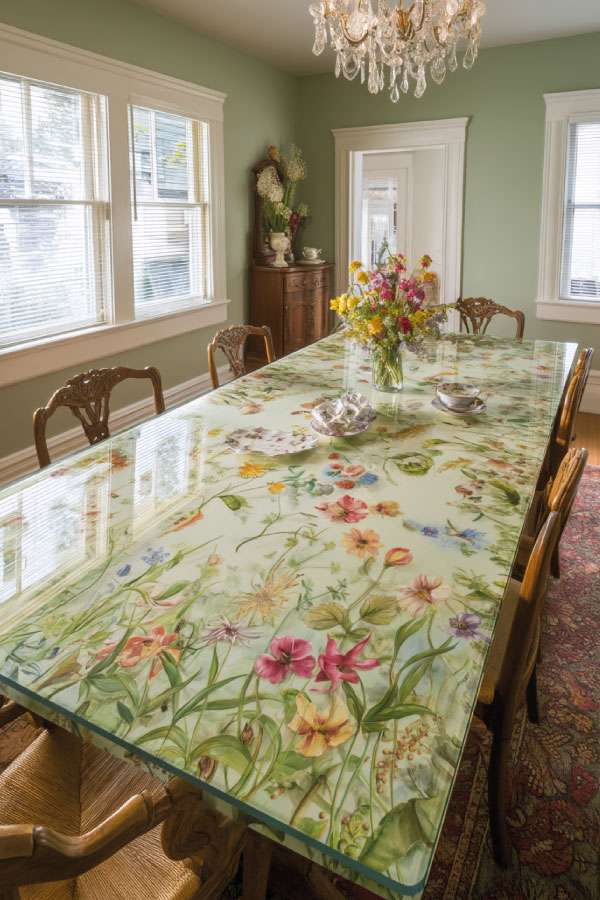
Sandwiching a beautiful vintage fabric between glass layers creates a protected, custom surface. It’s a wonderful way to showcase amazing textile patterns.
This technique preserves delicate materials from the past. It turns them into functional surfaces resistant to spills and scratches.
I find this method is perfect for seasonal changes. Swapping out the fabric for a new look takes just a few minutes.
Botanical prints can bring nature indoors. For a different vibe, geometric patterns add contemporary sophistication.
Grandmother’s linens can find new life as stunning tabletop art that honors family history.
A laminating film can help prevent the fabric from shifting. It ensures a bubble-free, professional-looking result.
It’s a totally unique look.
The custom fabric choice ensures your table will coordinate perfectly with your existing room decor.
11) Hairpin Leg Upgrade
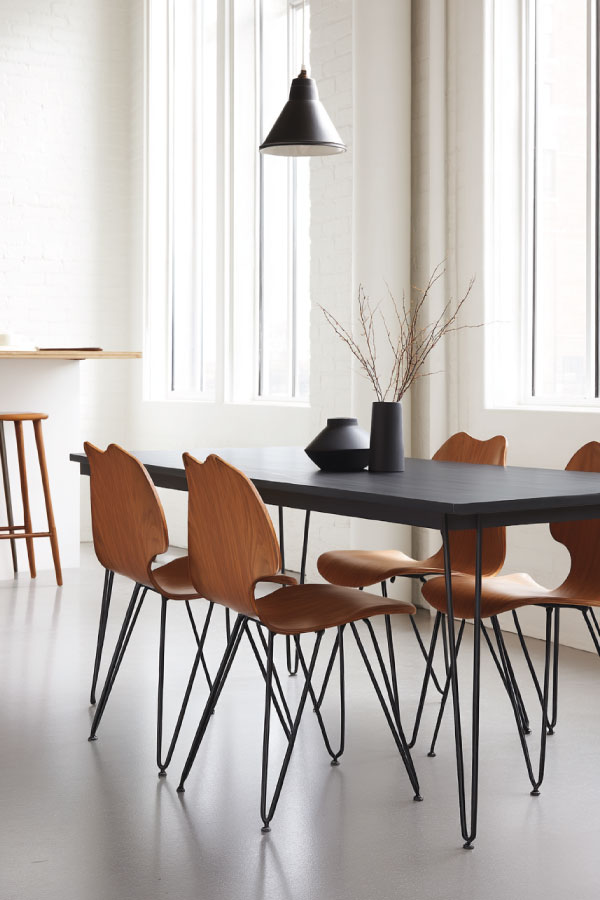
Mid-century modern hairpin legs can transform a heavy, traditional table. They create an airy, modern piece that feels surprisingly contemporary.
The sleek metal legs add an industrial edge. I notice they also maintain clean lines that work perfectly in minimalist spaces.
This is a quick and dramatic transformation. Installation requires only basic tools and takes less than an hour.
The open design of the legs makes a room feel larger. It allows light and sightlines to flow underneath the table.
A black powder coating resists scratches while maintaining a sleek, modern look.
You can also find them in copper and brass finishes. These add a touch of warmth while maintaining the modern aesthetic.
It’s an instant style lift.
Varying the leg heights allows you to create custom table dimensions perfect for your specific room requirements.
12) Book Page Collage Surface

Covering a tabletop with old book pages creates an intellectual charm. It’s a look that appeals to literature lovers and vintage enthusiasts alike.
Overlapping the pages builds a dimensional texture. It also tells a story through intriguing glimpses of printed words.
I enjoy selecting meaningful passages that reflect personal interests. It’s a way to embed your own story into the furniture.
Music scores can create a similar effect for musicians. Botanical guides are also a beautiful choice for garden enthusiasts.
Pages from foreign language books add an exotic, mysterious appeal.
A good sealant is crucial for this project. It preserves the paper and prevents the yellowing that would compromise the aesthetic.
It’s a table with a soul.
Dictionary pages can also offer a clean, typographic look that works wonderfully in a modern library or office.
13) Metallic Leaf Application

Applying gold leaf can transform an ordinary surface into a luxurious statement piece. It looks worthy of a high-end designer showroom.
The delicate application process requires patience. However, it delivers stunning results that photograph beautifully under any light.
I find the irregular patterns created by hand application are more appealing. They have a character that perfect machine precision lacks.
Sizing adhesive is what determines your working time. This allows for both quick applications and more detailed, precision work.
Real gold leaf can last for decades without tarnishing, making it a surprisingly durable choice.
For different looks, silver leaf offers a cool elegance. Copper provides a warm richness that’s perfect for autumn-inspired decor.
It’s pure, unapologetic glamour.
You can also do a partial leafing technique to create subtle accents that add glamour without overwhelming a room.
14) Carved Wood Medallion Detail

An architectural salvage medallion can add instant history and craftsmanship to a plain tabletop. It’s a simple upgrade with a huge impact.
These decorative elements create a beautiful focal point. They draw the eye while adding dimensional visual interest.
I was surprised how different stain colors on the medallions create completely different effects. You can really customize the look.
Mixing several medallion sizes can create a dynamic composition. The final result feels intentionally curated rather than accidental.
Antique wood carvings possess a character that new reproductions simply cannot replicate.
Mounting systems can preserve both the table and the medallion. This allows for future design changes if you ever want a new look.
It adds instant character.
When antique pieces aren’t available, modern wood appliques offer a similar visual impact at a fraction of the cost.
15) Two-Tone Paint Technique
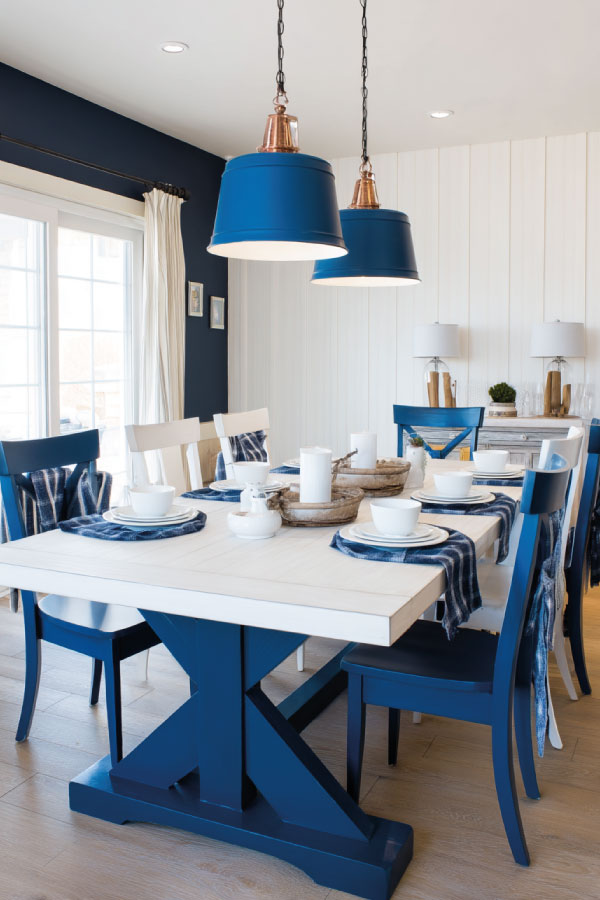
A two-tone paint technique creates so much visual interest. Using contrasting colors on the top and base helps to define the table’s shape.
This technique works especially well with complementary colors. The goal is to choose shades that enhance rather than compete with each other.
I enjoy how this approach lets you experiment with trendy colors. You can try a bold shade without committing the entire piece to it.
Using painter’s tape is the secret to getting crisp, clean lines. It’s what makes the final product look professionally finished.
Bold color combinations make furniture feel custom-designed.
A neutral base with a colorful top offers great flexibility. It’s easy to coordinate with seasonal decor changes throughout the year.
It’s a playful, graphic look.
Even tonal variations of the same color can create a subtle sophistication.
16) Stained Glass Window Insert

An antique stained glass panel can become a stunning piece of tabletop art. It will cast colorful light patterns throughout the room.
A protective glass top allows light to filter through the stained glass. It also keeps the delicate, original piece safe from damage.
I find architectural salvage yards are treasure troves for unique panels. They often have pieces with authentic historical character.
Placing LED strip lighting underneath the panel creates a dramatic evening ambiance. It can transform an ordinary dinner into a special occasion.
Morning coffee becomes a sacred ritual when surrounded by jewel-toned light.
A custom frame can secure the glass. This also allows for easy removal for cleaning or seasonal storage.
It’s a truly unique centerpiece.
You can also commission modern stained glass artists to create custom pieces that incorporate personal symbols or family meanings.
17) Industrial Pipe Base Frame

Building a table base from black iron pipes creates a substantial, industrial look. It can support even the heaviest of tabletops.
The modular system of pipes and fittings allows for custom sizing. I enjoy how you can design a base for any space while maintaining structural integrity.
This is a great DIY project because no welding is required. You can assemble it with basic plumbing skills and standard hardware store materials.
Pipe frameworks can feel both rustic and modern. The final vibe depends on the surrounding decor choices.
Galvanized fittings resist corrosion and develop an attractive patina with age.
Adding adjustable feet is a smart move. They can compensate for uneven floors and protect your surfaces from scratches.
It’s built to last.
This construction method can create family heirloom furniture that withstands decades of daily use.
18) Woven Rattan Apron Detail
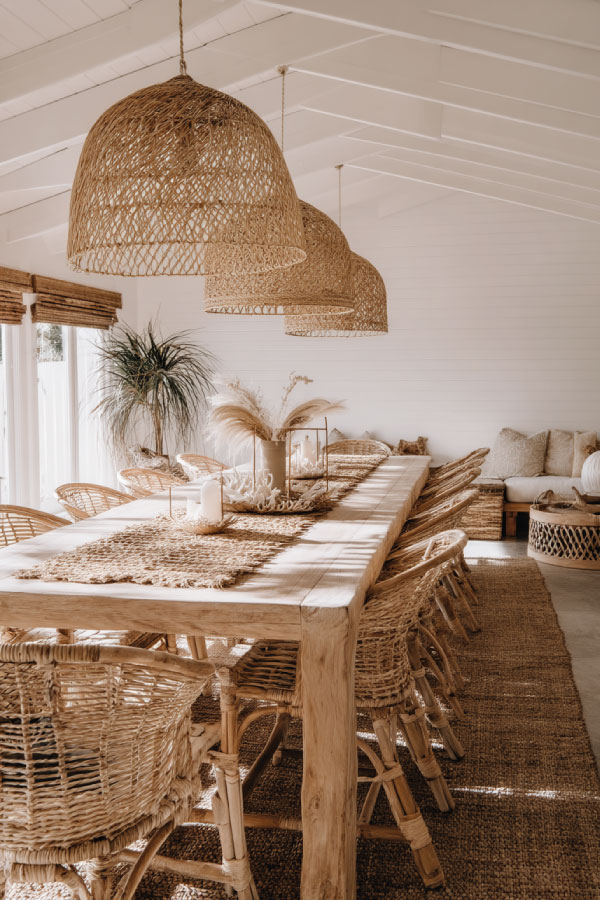
Adding a woven rattan detail to the apron of a table adds organic texture. It can instantly introduce a casual, coastal vibe.
The flexible material conforms easily to curved surfaces. It maintains its structural integrity under normal use.
I find rattan’s natural color variations are more interesting than uniform, manufactured materials. Each piece is slightly unique.
Pre-woven cane panels simplify the installation process. They also ensure a consistent pattern continuity around the table’s perimeter.
Handwoven patterns create beautiful shadow play that changes as the light shifts.
Regular dusting is all that’s needed to maintain its natural beauty. An occasional conditioning can prevent cracking in dry conditions.
It adds instant texture.
For high-humidity environments like kitchens, synthetic rattan offers a similar aesthetic with increased durability.
19) Vintage Hardware Upgrade

Antique drawer pulls and corner brackets can add authentic period details. They significantly elevate a simple table.
The patinated metal finishes provide a rich texture. I was amazed how beautifully they photograph under both natural and artificial light.
Different metals can create completely different moods. The hardware you choose has a huge impact on the final design.
Planning your mounting positions is crucial. It affects both function and aesthetics, and you want to avoid irreversible drilling mistakes.
Original hardware carries a history that makes a piece feel connected to past generations.
Reproduction hardware is a great alternative. It offers consistent availability while maintaining an authentic period style.
It’s jewelry for your furniture.
Mixing metal finishes can also create an eclectic charm that works beautifully in a collected-over-time decor scheme.
20) Botanical Pressed Flower Design

Pressing flowers under a glass or epoxy top preserves nature’s beauty. It creates unique, organic patterns that celebrate the seasons.
These delicate specimens require careful handling. The patience is rewarded with a stunning piece of permanent artwork.
I enjoy collecting flowers throughout the growing season. This allows you to create a comprehensive botanical display that tells a story.
Ferns and leaves can provide a structural green background. The flower petals then add delicate pops of color.
Each table becomes a botanical journal, recording specific moments in your garden’s life.
Multiple layers of sealant are needed to protect the flowers. This maintains the transparency that showcases their natural color.
It’s a piece of preserved nature.
This technique is also beautiful for memorial pieces, incorporating flowers from a meaningful location or event.
21) Chalkboard Paint Surface
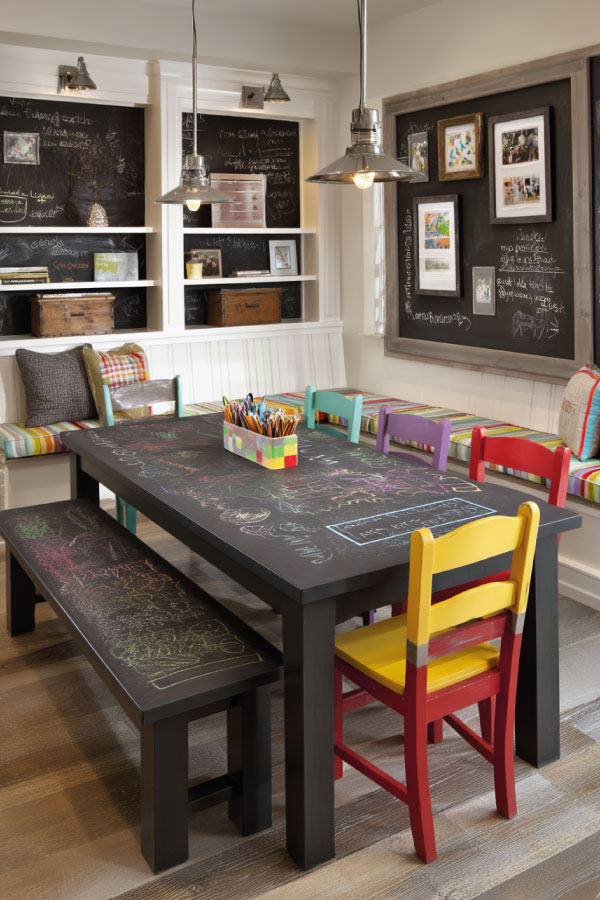
A functional chalkboard surface transforms a table into an interactive family message center. It’s a space for creative expression.
The classic matte black finish provides a sophisticated backdrop. It looks great with colorful chalk art and practical daily reminders.
I find chalkboard tables are perfect for casual dining areas. The focus is on function and fun rather than formal presentation.
Quality chalk is important to prevent scratching. A good eraser ensures a clean removal without ghosting or permanent marks.
Children’s artwork becomes temporary table decoration that changes daily.
Colored chalkboard paint offers fun alternatives to traditional black. You still get the same great writing functionality.
It’s interactive and fun.
Be sure to “season” the surface properly before the first use. This prevents chalk dust issues and ensures a smooth writing experience.
22) Mirror Mosaic Accent Border
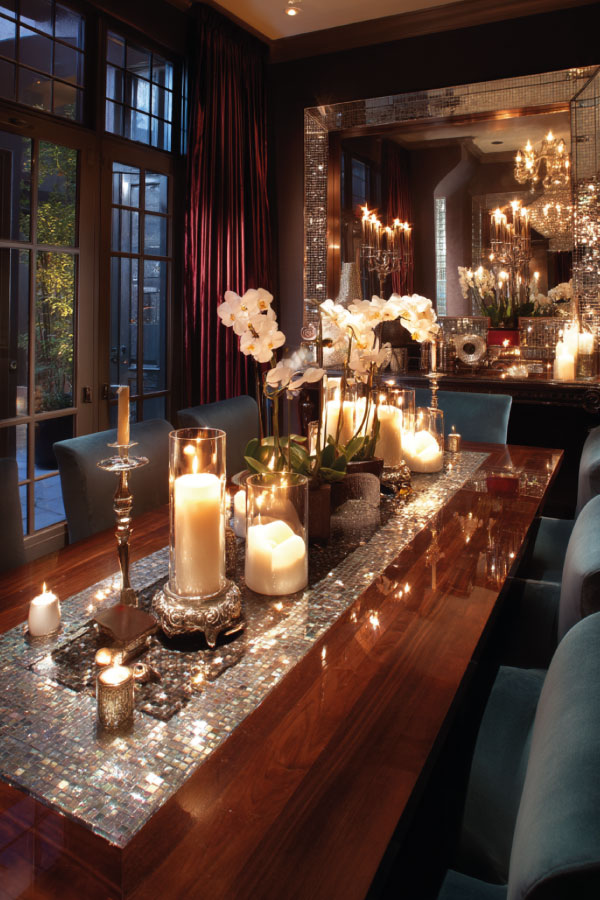
A border made of broken mirror pieces creates a glamorous, reflective edge. It adds a touch of sparkle to any dining experience.
The faceted surfaces multiply candlelight beautifully. This creates a romantic ambiance that enhances intimate dinner conversations.
I was surprised to learn that safety glass is a great option here. It breaks into smoother pieces that eliminate cutting hazards.
Grouting secures the pieces. It also creates a seamless transition between the mirrors and the surrounding table surface.
The reflective surfaces multiply candlelight for a romantic ambiance.
Antique mirror pieces can add a vintage charm. Modern mirrors will provide a clean, contemporary sparkle.
It’s a touch of unexpected glamour.
This technique works especially well around the edges of a table. The reflected light creates a magical effect.
23) Leather-Wrapped Edge Detail
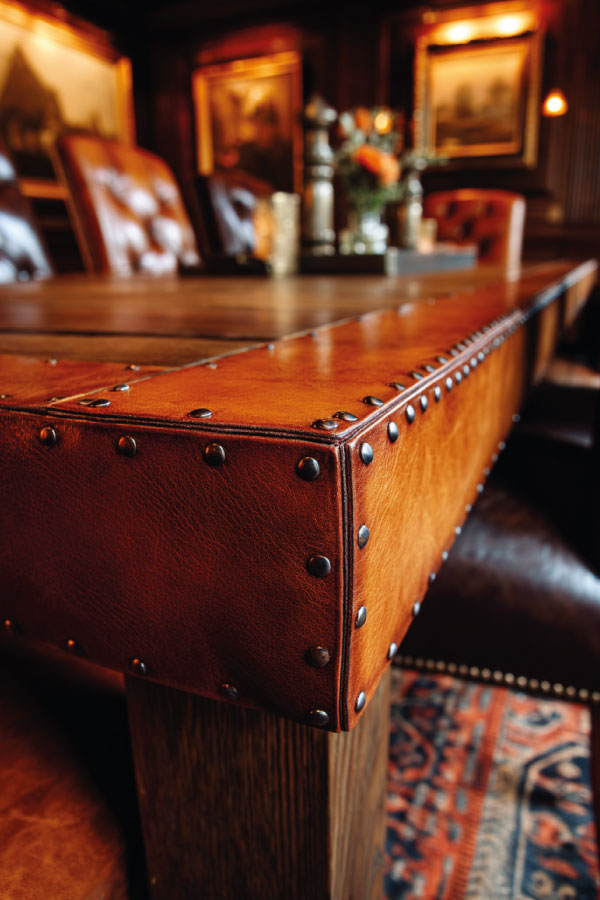
Wrapping the edge of a table in rich leather adds a luxurious texture. It also helps protect the corners from damage during daily use.
This natural material develops a beautiful patina over time. It becomes more attractive with age and handling.
I enjoy how this technique eliminates sharp corners. This is a great safety consideration in dining areas with small children.
Different leather finishes, from smooth to distressed, can create varying effects. You can tailor it to your specific decor style.
Brass tacks create an authentic equestrian style that brings an elegant feel to any space.
Contact cement is the best adhesive for this. It creates a permanent bond while allowing slight adjustments during installation.
It feels so sophisticated.
An occasional conditioning treatment will maintain the leather’s flexibility and prevent it from cracking in dry air.
24) Succulent Garden Integration
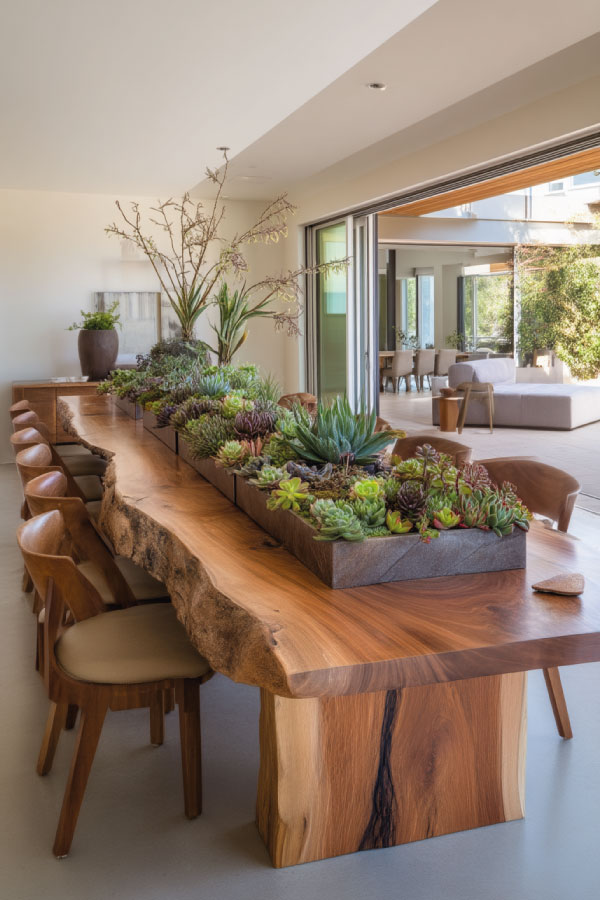
A built-in planter box can transform a table into a living garden. It purifies the air while providing beautiful, natural decor.
A proper drainage system is crucial. It prevents water damage to the table while ensuring healthy plant growth.
I find this approach is perfect for small spaces where a traditional garden isn’t a practical option. It’s a garden and table in one!
Removable inserts are a great feature. They allow you to rotate plants for optimal growth or accommodate seasonal decorations.
Low-maintenance succulents thrive indoors and create an ever-changing natural display.
Different succulent varieties provide wonderful color and texture variations. The display stays interesting without requiring frequent care.
It’s a living centerpiece.
This design also works beautifully for outdoor dining areas where weather resistance is important.
25) Vintage Wallpaper Decoupage

Antique wallpaper patterns create sophisticated surfaces that celebrate historical design. They bring an authentic period charm to any piece.
The intricate patterns add a wonderful visual complexity. You get this beautiful detail while maintaining a flat, functional surface.
I discovered this technique while renovating old homes. Some beautiful wallpapers deserved to be preserved rather than thrown away.
Coordinating wallpaper remnants with your existing room decor is key. This creates a cohesive design scheme that feels intentionally planned.
Each wallpaper tells a design story from a specific era, making the furniture a conversation piece.
Multiple coats of polyurethane are necessary to protect the paper. This ensures a durability that can withstand regular cleaning and use.
It’s a piece of history.
Modern reproductions can offer a similar aesthetic with improved paper quality for a long-lasting, beautiful result.

